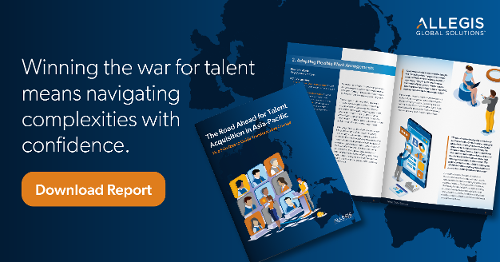The Changing Landscape of Talent Acquisition in the Asia-Pacific Region
The dynamic world of talent acquisition has experienced rapid change in workforce management over the last two years, making agility a major priority for organisations worldwide. With an agile, flexible approach, companies can more effectively acquire talent and drive greater value to the organization. We see several imperatives to that success, including:
- Staying on top of talent trends
- Strategically utilising data
- Enabling digital transformation
- Delivering a positive candidate experience
- Partnering with knowledgeable workforce experts
To explore these topics further, Allegis Global Solutions (AGS) partnered with HR Grapevine to poll 405 senior talent acquisition and HR practitioners in Europe to gather perspectives on strategic transformation, data and analytics, technology use, management of talent communities and more.
Interestingly, many trends uncovered in that report translate well to what we’re seeing in APAC. So, we recently sat down with AGS’ Vice President of the APAC Sarah Wong to explore considerations for businesses as they continue to assess their workforce strategies.
How is Talent Acquisition in Asia-Pacific Changing?
Wong: The COVID-19 pandemic led to border shutdowns and new global workforce protocols that have vastly changed talent acquisition in APAC. Rising talent shortages and the need for new, innovative ways of working, such as increased use of technology and remote onboarding of talent, have created new challenges for recruiting and human resources (HR) professionals.
Further, low hiring volumes for the past two years are now resulting in hiring spikes across many APAC countries as economies begin to recover from the pandemic. In addition, offshoring of work from Europe, North America, and the Middle East and Africa (EMEA) to APAC countries rose in 2021, translating into workforce growth in countries such as India, the Philippines and Malaysia.
While talent acquisition and HR professionals have generally responded well to the changes accelerated by the pandemic, it is evident that those who are succeeding are transforming talent acquisition into a strategic function.
How Can Companies Adapt to a Flexible Workforce?
Wong: The future of talent acquisition in APAC will necessitate learning how to navigate and exceed business needs utilising a flexible work model. For most industries and where the work needed to get done allows, the hybrid models of remote work are here to stay.
After the onset of the pandemic, talent acquisition professionals had to adjust quickly to a new remote workforce model. Agile talent acquisition efforts incorporated virtual interviews, digital hiring and remote work from local and distant candidates to allow businesses to continue growing and building a top-notch workforce.
A few key themes about flexible work arrangements that we continue to discuss with clients are:
- Expect flexible work to be the norm in competing for talent.
- Beyond equipment and access, companies should focus on creative ways to engage workers in a virtual world.
- Leverage data to direct and support decisions about targeting workers.
Where feasible, companies should look to reap the benefits of a ‘Team Anywhere’ approach as remote work continues to be a mainstay in APAC. For example, a company in Australia may need skilled talent to digitise their operations; however, there may be a shortage of local labour with the needed skills to do so. By embracing flexible work arrangements, the company could access workers from another country that boasts a wealth of skilled talent to fill their workforce needs – and gain an edge over companies that aren’t willing to be as flexible.
How Can Data Improve Talent Acquisition in APAC?
Wong: Our report found that 67% of talent acquisition and HR professionals are not measuring candidate experience, and 40% do not use data to support when or where to hire new talent.
Taking advantage of data remains an opportunity for many organisations as they build their hiring strategies. A talent acquisition function can explore incorporating people analytics to build consistent data definitions, and use reporting and analytical tools and data integration capabilities to track activities and engagements.
By measuring and analysing data, your team can ascertain the right skills for the right locations and better predict the best candidates for the company’s needs.
Several metrics can be used to improve talent acquisition in APAC companies. Some of these include:
- Inventories to identify skill surpluses and shortfalls within roles and geographies
- Candidate relationship management (CRM) systems for talent pool insights
- Employee engagement surveys for evaluating new-hire satisfaction, retention risk and hiring manager success
Metrics, properly utilised, can help any market benefit from data-driven intelligence that clearly conveys progress, gaps or areas of action.
How Can Technology Help Build an Effective Workforce?
Wong: Data-based decision-making can be aided by utilising best-in-class technology. In fact, incorporating a technology plan into an organisation’s talent acquisition strategy can improve the overall effectiveness of building, strengthening and maintaining a productive workforce.
Worldwide, there has been a shift toward automated systems in most industries. In the hiring space, these advancements can aid and expedite the talent acquisition process with platforms such as quick online self-booking tools and CV scanners. Our research indicates an increased interest in adding new and innovative recruiting methods, with technology as part of that plan. Digital solutions are paramount to boosting engagement and nurturing strategy.
How Do I Foster Connections to Talent Communities?
Wong: By prioritising real interactions with candidates, your industry community and current employees, your company fosters authentic connections with a talent community that can yield increased productivity, as well as a reputation that attracts high-quality talent.
Here are a few tactics for nurturing a talent community and standing out as an employer of choice:
- Request candidates’ participation regularly
- Engage the business to encourage conversations
- Review comments shared and return feedback with follow-up actions
- Share the organisation’s mission and vision to promote their brand
-min.png)





